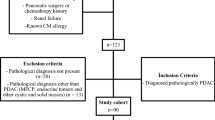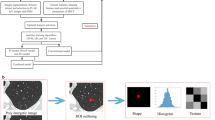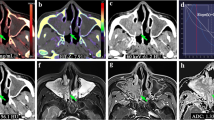Abstract
Purpose
To evaluate the therapeutic efficacy of radiofrequency ablation (RFA), quantitative water-based, and iodine-based images of gemstone spectral computed tomography (CT) were analyzed.
Patients and methods
30 patients underwent lung RFAs from March 2012 to March 2013. Through enhanced chest scans, we obtained the tumor size values by conventional CT images, and quantitatively analyzed the densities of iodine and water in lung tumors from water-based and iodine-based material decomposition images.
Results
Tumors in 22 cases increased in size after RFA while there was no detectable change in the remaining 8 cases. Through water-based material decomposition images, the water content in the tumors increased from (1014.76 ± 6.83 mg/mL) to (1022.71 ± 10.16 mg/mL) after RFA, and this difference was significant (t = −2.329, p < 0.05). Through iodine-based material decomposition images, the iodine content in the tumors was 2.49 ± 0.74 mg/mL before RFA. The tumors were mostly or completely necrotized after RFA and the iodine content in the area of necrosis reduced to 0.45 ± 0.29 mg/m (t = 11.072, p = 0.000).
Conclusion
By comparing the tumor size, water content and iodine content before and after RFA, we can visualize the morphology and metabolic states of the tumors and evaluate the therapeutic efficiency.





Similar content being viewed by others
References
Fernando HC, De Hoyos A, Landreneau RJ et al (2005) Radiofrequency ablation for the treatment of non-small cell lung cancer in marginal surgical candidates. J Thorac Cardiovasc Surg 129:639–644
Galbis-Caravajal JM, Pallardo-Calatayud Y, Revert-Ventura A et al (2008) Computed tomography-guided radiofrequency ablation of malignant lung lesions: early experience. Arch Bronconeumol 44:364–370
Ambrogi MC, Lucchi M, Dini P et al (2006) Percutaneous radiofrequency ablation of lung tumours: results in the mid-term. Eur J Cardio-thorac Surg 30:177–183
Goldberg SN, Gazelle GS, Mueller PR (2000) Thermal ablation therapy for focal malignancy: a unified approach to underlying principles, techniques, and diagnostic imaging guidance. AJR Am J Roentgenol 174:323–331
Ahmed M, Liu Z, Afzal KS et al (2004) Radiofrequency ablation: effect of surrounding tissue composition on coagulation necrosis in a canine tumor model. Radiology 230:761–767
Rose SC, Thistlethwaite PA, Sewell PE et al (2006) Lung cancer and radiofrequency ablation. J Vasc Interv Radiol 17:927–951
Higaki F, Okumura YS, Sato T et al (2008) Preliminary retrospective investigation of FDG-PET/CT timing in follow-up of ablated lung tumor. Ann Nucl Med 22:157–163
Boroto KM, Remy-Jardin T, Flohr JB et al (2008) Thoracic applications of dual-source CT technology. Eur J Radiol 68:375–384
Yamamoto A, Nakamura K, Matsuoka T et al (2005) Radiofrequency ablation in a porcine lung model: correlation between CT and histopathologic findings. AJR Am J Roentgenol 185:1299–1306
Suh RD, Wallace AB, Sheehan RE et al (2003) Unresectable pulmonary malignancies: cT-guided percutaneous radiofrequency ablation–preliminary results[J]. Radiology 229(3):821–829
Sawabata N, Ohta M, Maeda H (2000) Fine-needle aspiration cytologic technique for lung cancer has a high potential of malignant cell spread through the tract. Chest 118:936–939
Beland MD, Wasser EJ, Mayo-Smith WW et al (2010) Primary non smallcell lung cancer:review of frequency location and time of recurrence after radio frequency ablation. Radiology 254(1):301–307
Chae EJ, Song JW, Krauss B et al (2010) Dual-energy computed tomography characterization of solitary pulmonary nodules. J Thorac Imag 25(4):301–310
Imafuji A, Hara M, Sasaki S et al (2012) Usefulness of dual-energy CT scanning at 80 kVp for identifying hilar and mediastinal structures: evaluation of contrast enhancement of the pulmonary vessels and lymph nodes. Jpn J Radiol 30:69–77
Author information
Authors and Affiliations
Corresponding author
Ethics declarations
Conflict of interest
No conflict of interest exists.
Ethical approval
All procedures performed in studies involving human participants were in accordance with the ethical standards of the institutional.
Informed consent
Informed consent was obtained from all individual participants included in the study.
Rights and permissions
About this article
Cite this article
Liu, L., Zhi, X., Liu, B. et al. Utilizing gemstone spectral CT imaging to evaluate the therapeutic efficacy of radiofrequency ablation in lung cancer. Radiol med 121, 261–267 (2016). https://doi.org/10.1007/s11547-015-0602-5
Received:
Accepted:
Published:
Issue Date:
DOI: https://doi.org/10.1007/s11547-015-0602-5




